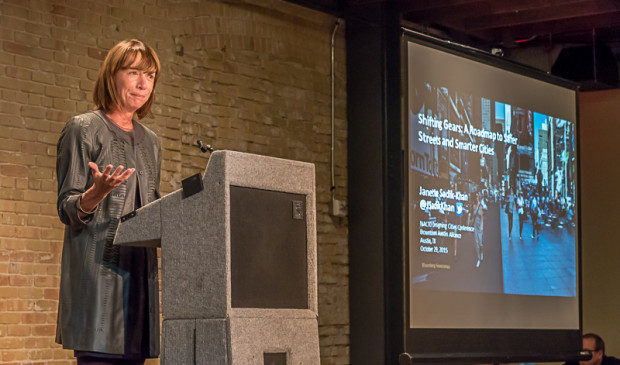Austin hosts mobility conference, former official
Monday, November 2, 2015 by
Tyler Whitson Hundreds gathered in and around Brazos Hall in downtown Austin on Thursday to hear what former New York City Department of Transportation Commissioner Janette Sadik-Khan had to say about the future of transportation planning in cities across the world, including Austin.
“I think we’re in this really important moment, this sort of urban revolution,” Sadik-Khan said. “And it is really exciting to see what Austin has underway, translating these principles into new projects on the ground – bike, bus and pedestrian programs. And I think it’s even more exciting to think about where you go from here.”
The keynote event, hosted by the Downtown Austin Alliance, took place as part of the National Association of City Transportation Officials’ fourth annual Designing Cities conference, which chose Austin as its host city this year.
Sadik-Khan, who chairs the association, referred to a movement among transportation officials in major cities across the nation to redesign urban streets in a way that emphasizes safety and mobility for all modes of transportation. Around 650 of those officials attended the conference, and those who heard the keynote speech cheered enthusiastically at Sadik-Khan’s words.
“It led to this flowering of innovation all across the country,” said Sadik-Khan, referring to the association’s urban street and urban bikeway design guides. She said new strategies are “flipping the old hierarchy on its head” by prioritizing “people on two feet and two wheels and in transit” instead of “focusing on moving cars above everything else.”
Sadik-Khan, who led a transformation of New York City streets between 2007 and 2013 – including the “pedestrianization” of Times Square – acknowledged that many have also criticized her initiatives, which included installing protected bike lanes, bike share stations, pedestrian plazas and dedicated bus lanes and removing traditional traffic lanes and parking spots.
Sadik-Khan defended those projects and the work she currently does as transportation principal at Bloomberg Associates by pointing out cases in which her initiatives have reduced traffic fatalities and increased nearby retail sales. She also pointed to a 2013 New York Times public opinion poll that found significant support for bike sharing, pedestrian plazas and bike lanes.
Mayor Steve Adler, for one, extolled Sadik-Khan’s work and principles when introducing her.
“I had the opportunity not too long ago to spend some time with Mayor (Bill) de Blasio in New York, and at one point he pulled me aside, and he whispered in my ear and said, ‘You know, Austin, Texas, may be the only city in the country that’s cooler than New York,’” Adler said. “Just think how cool Austin would be if we did, in this city, the things that Janette did in New York.”
Adler continued. “It wasn’t just about a couple of days ago that I was having yet another conversation about what we’re doing in this city, taking four lanes of congested traffic just down the street … and taking away two of those lanes for buses and for bicycles,” he said. “That is counterintuitive to so many people, and it is where those tectonic plates hit that this city is right now.”
The city has installed dedicated bus lanes on Guadalupe and Lavaca streets between Cesar Chavez Street and Martin Luther King Jr. Boulevard to allow greater speed for buses using the two existing Capital Metropolitan Transportation Authority MetroRapid service routes.
Adler explained the rationale for cutting traffic lanes in favor of alternatives. “Let’s imagine just for a second if we could put two more in there. … What happens in 10 years when we have 1 million more people in our metropolitan area?” he asked. “The answer almost everyone will give you, including the people in this conversation, is that in 10 years, that road fails, too.”
Congestion, of course, is not the only major problem that Austin residents are facing due to the city’s explosive growth. Affordability, or the opportunity for longtime residents to continue to live in the city despite skyrocketing property values and rents, was perhaps the most talked-about issue during last year’s City Council election campaign season.
When the Austin Monitor asked about the relationship between these two issues, Sadik-Khan brought up car ownership. “One of the most important things is to make it possible for people to get around without a car,” she said. “The average cost of a car is something like $10,000 a year. That’s $10,000 that can be used for education, for housing, for childcare, for mortgages, for anything.”
According to the American Automobile Association, better known as AAA, it cost an average of $8,876 per year in 2014 to own an “average” sedan, with other prices varying based on car type.
“Making it possible to get around easily, affordably, safely, healthily, on bikes, walking, on buses – and actually making those be real options – is really important,” Sadik-Khan continued. “And it’s really important to also understand that safety and sustainability and affordability, they all go together, they’re not disparate little things.
“I say I’m ‘pro-choice’ because I’m about choices,” Sadik-Khan added. “A great city has great choices – lots of ways to get around.”
The conference, which included dozens of speeches, presentations, workshops and panel discussions with transportation officials and others from across the country, took place in downtown Austin between Oct. 28 and 31.
Topics included public transit, bicycle and pedestrian initiatives, street redesign and new technology such as self-driving cars and transportation apps.
This reporter participated in a panel discussion in order to outline local transportation issues and initiatives.
Photo of Janette Sadik-Khan courtesy of Michael Knox, city of Austin.
You're a community leader
And we’re honored you look to us for serious, in-depth news. You know a strong community needs local and dedicated watchdog reporting. We’re here for you and that won’t change. Now will you take the powerful next step and support our nonprofit news organization?









